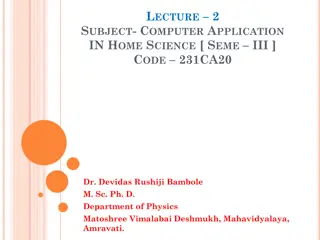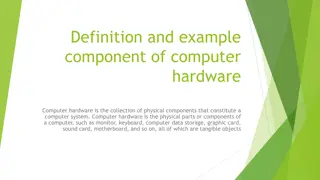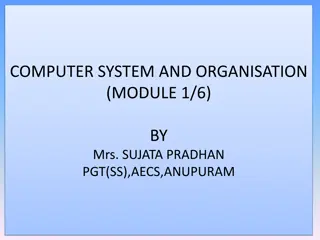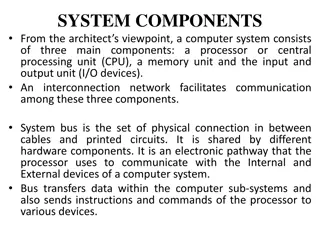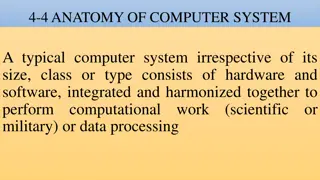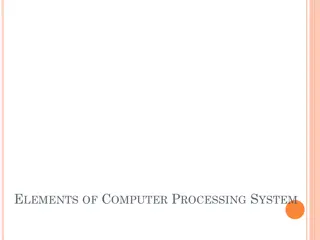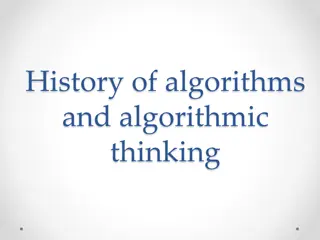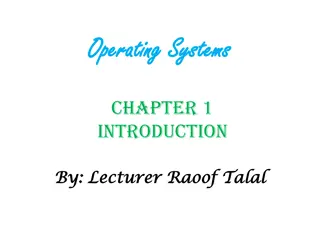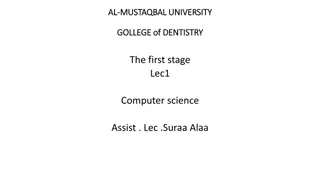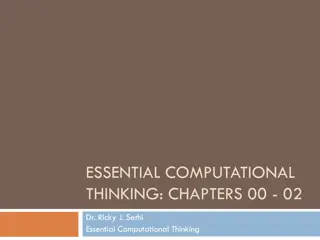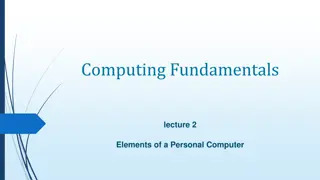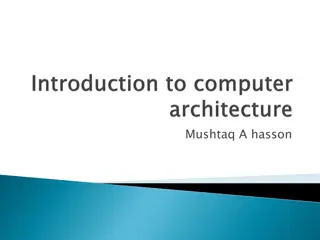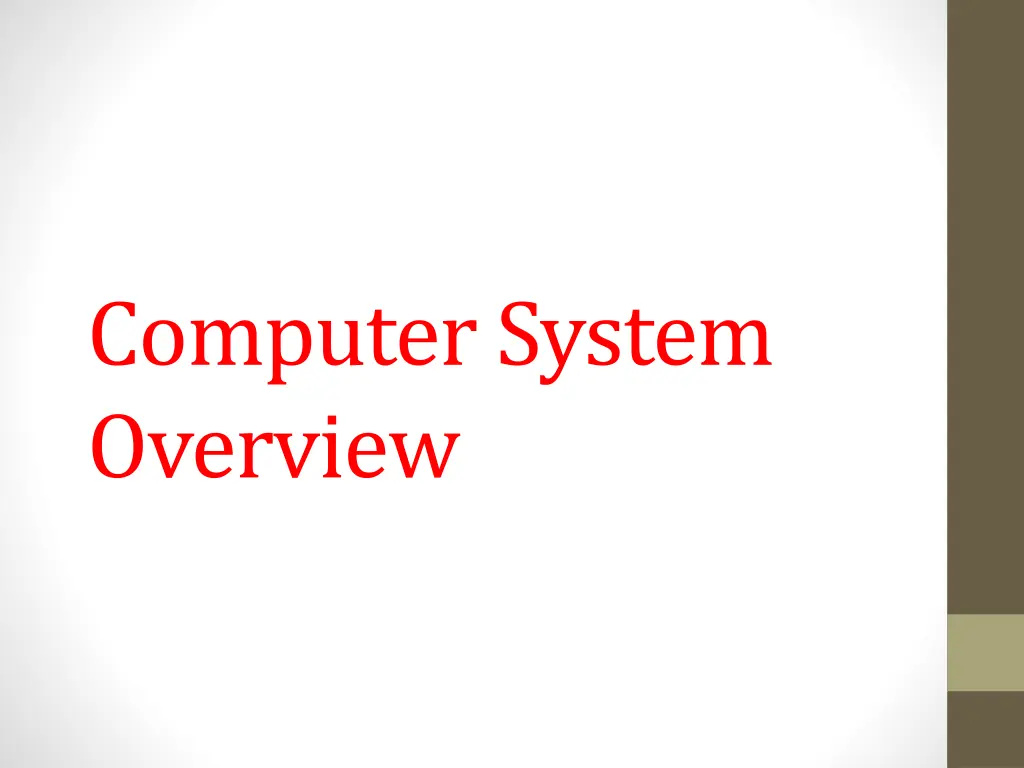
Exploring Computer System Components and Functions
Discover the various components of a computer system, including input and output devices, the CPU, primary and secondary storage, ALU, and control unit. Learn about the basics of computer organization and the significance of input devices in data entry.
Download Presentation

Please find below an Image/Link to download the presentation.
The content on the website is provided AS IS for your information and personal use only. It may not be sold, licensed, or shared on other websites without obtaining consent from the author. If you encounter any issues during the download, it is possible that the publisher has removed the file from their server.
You are allowed to download the files provided on this website for personal or commercial use, subject to the condition that they are used lawfully. All files are the property of their respective owners.
The content on the website is provided AS IS for your information and personal use only. It may not be sold, licensed, or shared on other websites without obtaining consent from the author.
E N D
Presentation Transcript
Computer System Overview
Input Devices Keyboard. Mouse. Scanner. Light pen. Barcode Reader. Microphone. Touchscreen. Joystick.
Output Devices Monitors, Printers, Speakers, Headphones, Projectors, GPS devices, Optical mark readers and Braille readers.
CPU(Central Processing Unit) A central processing unit (CPU), also called a central processor, main processor, or just processor, is the most important processor in a given computer.
Components of a computer system
Functions of ALU and Control unit The Arithmetic Logic Unit (ALU) is a digital circuit responsible for performing arithmetic and logic operations on data, while the Control Unit (CU) is responsible for coordinating and regulating the operation of the computer's other components, including the ALU.
Primary Storage It is commonly used to store data or information on which the computer is presently working; therefore, we can call it a temporary storage device. When the systems are turned off, data and information are lost. Types of primary memory: RAM: Random Access Memory.
Secondary Storage Secondary memory refers to the more permanent storage. Hard disks and flash drives are examples of secondary memory. Before instruction execution, a CPU component called the control unit is necessary for transferring data or instructions from secondary memory into main memory.
Basics of Computer Organisation
Input Devices A piece of equipment/hardware which helps us enter data into a computer is called an input device. For example keyboard, mouse, etc.
Output Devices A piece of equipment/hardware which gives out the result of the entered input, once it is processed (i.e. converts data from machine language to a human- understandable language), is called an output device. For example printer, monitor, etc.
Registers Registers are a type of computer memory used to accept, store, and transfer data and instructions used by the CPU right away. Processor registers refer to the registers used by the CPU. During the execution of a program, registers are used to store data temporarily.
Memory Unit A memory device refers to a device that can store data. The quantity of data stored in a unit of memory is called a memory unit. Furthermore, we quantify its storage capacity in bytes.
Main Memory What is the main memory of a computer? The main memory of a computer can also be called as primary memory. It is also known as Random Access Memory (RAM).
Contd The main memory of a computer can also be called as primary memory. it is also known as random access memory that is RAM . when computer is shut down all the data in RAM is erased. primary memory is computer memory that is accessed directly by the CPU .
RAM(Random Access Memory) The full form of RAM is random access memory. It is a memory device that is located on the motherboard of a computer and is used as the area of memory where the computer temporarily stores its work. RAM is volatile, which means that the contents of memory can be erased when electricity is removed from it.
Features of Static RAM Static random access memory has its importance as the memory of choice for cache memory. Here are some of its features. SRAM has a lower access time, around ten nanoseconds. It is much faster than DRAM as the memory cells do not require to be continuously refreshed. However, it consumes more power since it uses a bi-stable latch circuit, and requires a regular power source. It is costly and exists on the processors between the processor and main memory. It is long-lasting. As a part of the computer RAM, SRAM is entirely necessary but expensive.
DRAM DRAM computer RAM is useful to have as a cheaper memory option. It usually serves as the main memory. DRAM has a much higher access time of around 50 nanoseconds. It is slower than SRAM because memory cells need to be continuously refreshed. It consumes less power because the information is stored in one capacitor. DRAM is less expensive than SRAM. One memory cell is made up of one transistor and one capacitor so it occupies less space on the same-sized chip, providing you with more memory than an SRAM of similar size. DRAM random access memory is the best cost-saving memory.
Types of ROM(READ ONLY MEMORY) ROM comes in various types, each with its unique characteristics and applications. These include Programmable ROM (PROM), Erasable Programmable ROM (EPROM), Electrically Erasable Programmable ROM (EEPROM), and Mask ROM. Each type has specific features regarding programming, erasing, and data retention(the practice of storing data for a specific period of time).
PROM A programmable read-only memory (PROM) is a form of digital memory where the contents can be changed once after manufacture of the device. The data is then permanent and cannot be changed.
EPROM An EPROM (rarely EROM), or erasable programmable read- only memory, is a type of programmable read-only memory (PROM) chip that retains its data when its power supply is switched off. Computer memory that can retrieve stored data after a power supply has been turned off and back on is called non-volatile.
EEPROM EEPROM stands for Electrically Erasable Programmable Read Only Memory. This type of ROM can be erased and programmed with the help of an electric pulse.
Cache Memory To speed up the operations of the CPU, a very high speed memory is placed between the CPU and the primary memory known as cache . It stores the copies of the data from frequently accessed primary memory locations , thus, reducing the average time required to access data from primary memory.
Contd... Secondary memory is where programs and data are kept on a long-term basis. Common secondary storage devices are the hard disk and optical disks. The hard disk has enormous storage capacity compared to main memory. The hard disk is usually contained inside the case of a computer.
Contd... A hard disk drive consists of a rigid disc made with non- magnetic material, which is coated with a thin layer of magnetic material. Data is stored by magnetizing this thin film. The disk spins at a high speed and a magnetic head mounted on a moving arm is used to read and write data.
CD(Compact Disc) A compact disc is a portable storage medium that can record, store and play back audio, video and other data in digital form.
Types of Compact Disk There are three main types: (i) CD-ROM (Compact Disk Read Only Memory) This is used to store information and cannot be used to store data.It is mainly used for CD distribution. For eg Software,Games,e-books etc. (ii)CD-R (Compact Disk Recordable) It is mainly used for CD-R and can be written on only once and disk can t be erased.
Contd... (iii) CD-RW(Compact Disk Rewritable) CD-RW is an erasable disk you can write on multiple times.
DVD The correct answer is Digital Versatile Disc. DVD, also known as Digital Versatile Disc or Digital Video Disc, is an optical disc storage media format. It was developed and invented in 1995 by Sony, Panasonic, and Samsung. Its main use is to store video and data.
Types of DVD DVD media comes in several formats; including DVD+R (recordable DVD), DVD+RW (re-writeable DVD), DVD-RAM (random access memory) and DVD-ROM (read only memory).
Flash Memory A flash drive is a small,ultra-portable storage device with a Solid State memory. For eg It has no moving parts inlike magnetic storage devices,nor does it make use of lasers-unlike optical drives. The key difference is that data is retained in flash memory even the power is switched off. They are now fairly inexpensive,costing from 250 /- Typical sizes range from 256 Mbytes up to 128 GB and beyond.
BluRay Disk Blu-ray Disc (also known as Blu-ray or BD) is an optical disc storage media format.Its main uses are high definition video and data storage. The disc has the same dimensions as a standard DVD or CD. While current optical disc technologies such as DVD,DVD(add or minus)R,DVD(add or minus) RW and DVD-RAM rely on a red laser to read and write data,the new format uses a blue violet laser instead,hence the name Blu-ray. This allows data to be packed more thighly and stored in less space,so it s possible to fit more data on the disc even though it s the same size as a CD/DVD.Blu Ray disks of today are capable of storing upto 128 GB of data.
The System Bus The system bus (or the bus) is an electronic pathway composed of connecting cables and that connects the major components of a computer system.Though system bus,data and instructions are passed among the computer system components. The data carrying part of system bus is called data bus. The control instruction carrying part of system bus is called control bus. The memory address carrying part of system bus is called Address bus. A separate type of bus called I/O Bus connects the Input,Output and other external devices to the system.
Mobile System Organization Some of the important parts of the mobile are -: Mobile Processor -> It means the brain of the mobile. Camera ISP -> the part which processes the images and videos. Display Unit -> provides display & touch interface to us. Memory Unit -> storage unit of the mobile Power Management/Battery Management -> battery of the mobile. External Storage -> also considered as expandable storage.
Mobile Processor Mobile Processor The mobile processor is the CPU (Central Processing Unit) of our mobile. It processes a million of command per second. It provides the backbone to our mobile phone, due to which, the Operating system of our mobile works, and all the pre- installed as well as installed application works, the Processor receives the command, then processes it, and then forms an output.
Contd Also, it performs all the calculations as same as the CPU. Without the processor, our mobile is unable to open and perform its functions. Thus, the Processor is a very important device for our mobile. It is mainly divided into three parts which are -: CPU Communication Processing Unit APU Application Processing Unit GPU Graphical Processing Unit
CPU CPU It is also known as DSP (Digital Signal Processor). because it converts analog signals into digital signals. It stands for Communication Processing Unit, As the name suggests that it is that part of the Mobile Processor which helps us to make and receive calls. We could call each other because of this part of the processor. It is also divided into two parts, which are -: RSMU (Radio Signal Management Unit) Audio Subsystem
APU and GPU APU APU stands for Application Processing Unit. As its name suggest that it is part of the mobile processor which runs all the applications (pre-installed and installed by the user). APU executes every application, which is on the mobile. GPU GPU is the second part of the Mobile Processor. It stands for Graphical Processing Unit. It is that part of the mobile processor that processes our mobile s graphics and designs. The more the quality of the GPU, the more we will get high- quality graphics.
Camera ISP Now, in this section, we are going to read about the camera ISP. Here, ISP stands for Image Signal Processing. It is that part of our mobile system which processes the images and videos. All the images, and videos that are taken from our camera, are part of this camera ISP. It has a special image signal processor which processes the things like instant image capturing, high-resolution support, image stabilization, and image enhancements.
Display unit Display Unit This unit is not in the Mobile System Organization for class 11. But it is important to read this. Display Unit is that unit of the mobile phone which provides us display & touch interface. We could scroll our mobile phones because of this unit only. Most mobiles use an OLED display. Because, it has a very smooth and fast processing as well as it could be scrolled easily.
Memory Unit The memoryUnit means the part of the mobile which stores the data, files, and information in it. It also processes the data. It stores text documents, images, videos, pictures, songs, etc. In mobiles, there are mainly two types of memory, which are -: RAM Random Access Memory ROM Read Only Memory
RAM It is the main working memory of our mobile. All the installed applications are first loaded on RAM, and after that, they were executed. If our mobile phone will have better RAM, then its processing power will also be better. RAM is unable to work if the power supply of the electricity goes off. This means it is a volatile memory. To know about the RAM of the computer you could visit the link. More about the RAM of the computer.
ROM It stands for reading Only Memory. It is the internal storage of the mobile. No user could write anything on it, and thus it sounds like Read Only . ROM part of the memory resides near the Operating System of the mobile. In ROM, some apps could not be deleted by the user s end. Examples WhatsApp, YouTube, Gmail, etc. To know about the ROM memory of the computer you could visit the link. More about the ROM of the computer.
Power Management Power Management means that part of the mobile supplies the power to the mobile, due to which the mobile phone could work and process. Batteries are that part, because of which mobile works. Most phones are formed with Lithium (Li+) ion batteries. The capacity of the battery is measured in MAh. MAH stands for Milliampere-hour. The more the capacity of the battery, the more mobile could work.
External Storage External Storage is also known as Expandable Storage. It means that storage which could be externally added to mobile phones. It can be removed and added easily. There are many devices these days, for example SD cards, Micro SD cards, etc. We could store here text documents, images, videos, pictures, songs, etc. It is somewhat similar to Secondary Memory in computers.
Advantages of Mobile System In this section, we are going to read some of the main advantages of mobiles, which are -: Mobiles are small computers, which can process a large set of data within a second. We could connect to the internet through our mobile phones. We could easily communicate in any place on the earth. We could capture images, and videos from our mobile phones, and edit them.


